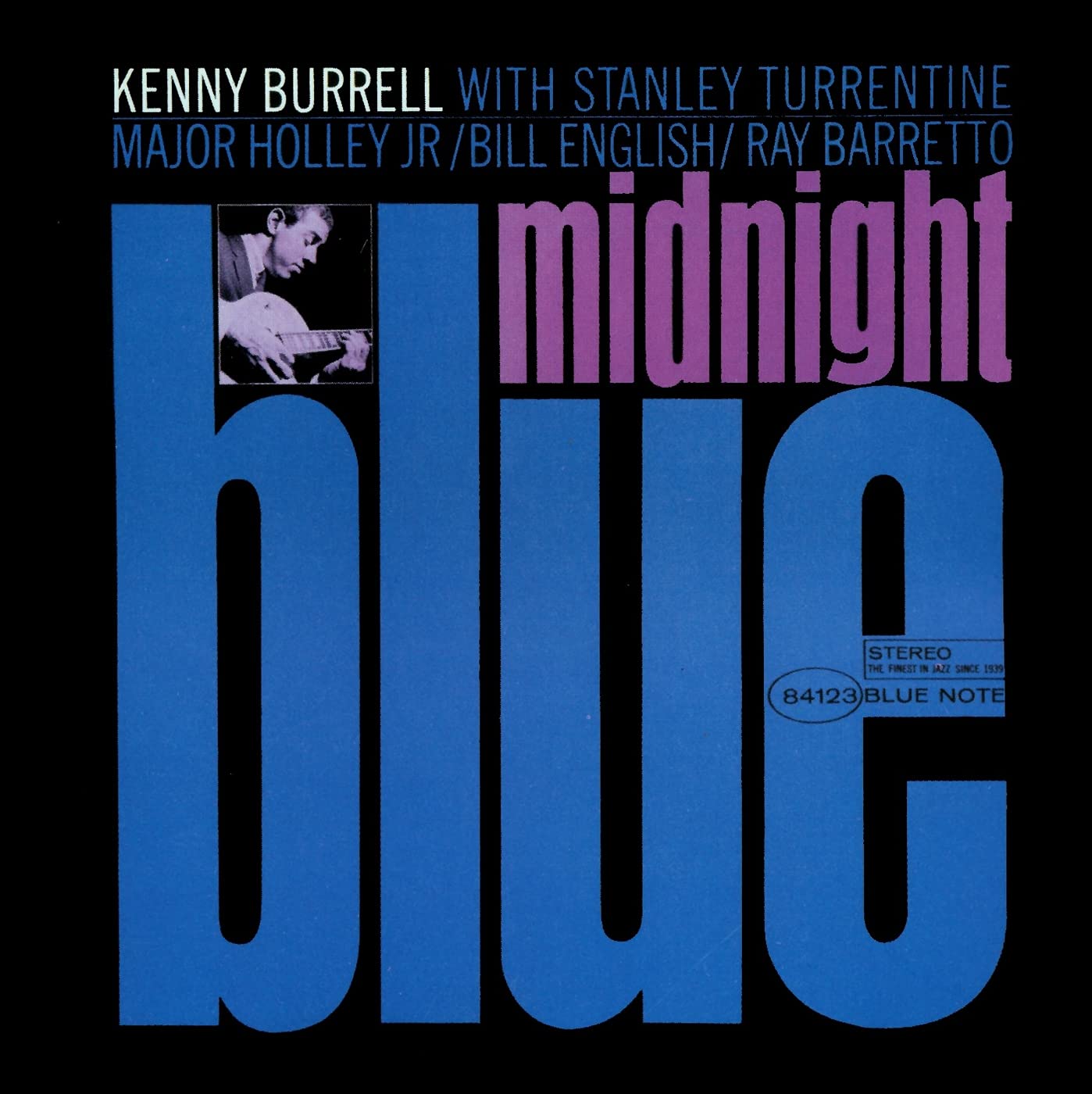I stole some nice words from the web and added a few of my own for a nice write up, which can also be found in the first post of this thread.
Kenny Burrell - Midnight Blue*
Something about guitar jazz has always fascinated me personally. Whether it be Grant Green, who is perhaps my all time favourite Blue Note artist, or Kenny Burrell, guitar almost always seems to be featured om my most spun jazz albums. And especially so if that jazz guitar had a hint of soul or blues in its sound.
BB King once said, “Jazz is the big brother of the blues. If a guy’s playing blues, he’s in high school. When he starts playing jazz it’s like going on to college.” It wouldn't be stretch to imagine that he might have had Kenny Burrell's
Midnight Blue in mind.
Kenny Burrell made his major debut with Dizzy Gillespie in 1951 and has gone on to make eighty albums across eight high profile record labels as a leader and very many more within the bands of many jazz giants including Oscar Peterson, John Coltrane, Billie Holiday and Jimmy Smith with whom he recorded the highly popular "Organ Grinder Swing " album in 1965. It is sad to note that recently Kenny, who was living in Westwood California with his wife Katherine Goodrich, who is 37 years younger than him, is enduring hard times both medically and socially and finds himself totally isolated and having to crowd fund for both his accommodation and physical needs. Not so long ago he was working as The Director of Jazz Studies in The Herb Albert School of Music at The University of Southern California.
How different were things on January 8, 1963, when he stepped into Rudy Van Gelder’s studio in Englewood Cliffs, New Jersey. From the very first track, it’s clear why this album was so popular when it was released and has remained so ever since. It oozes early 1960s sophistication, like the soundtrack to a movie about love gone sour in Manhattan’s Upper West Side. Reid Miles‘ album cover is perfection, summing up the mood of this album with just perfect typography.
It’s been called “as elegant a record as the label ever released,” and it’s impossible to disagree. On tenor saxophone was Stanley Turrentine from Pittsburgh, a powerful player full of blues and soul filled overtones gained from his early R & B days with Earl Bostic. Bass man Major Holley, a prolific studio musician who also spent time with Duke Ellington, Zoot Sims and the like was an ideal foil for the guitarist with his large rounded tone and impeccable sense of time, alongside the percussion team of ex blues drummer Bill English and the Latin styled conga player originally from Puerto Rica, Ray Barretto.
All the tracks, except one are composed by the guitarist and things kick off with the almost exotic Chitlins Con Carne where Barretto's congas set the scene for the first of many understated but highly imaginative outings by the leader throughout the album. Stanley Turrentine provides a blues drenched tenor solo on this one, although he is not offered too many opportunities to shine during the session overall. Mule a tune co-written with Major Holley follows, it has a great feeling of reflective calm about it with intricate guitar lines well responded to by the co-writer's double bass contribution. Just as the title suggests Soul Lament is just that with its deep mood and melancholy theme leaving a lasting impact on the listener despite its brief duration.
Midnight Blue the title track has perhaps the most memorable thematic lines of the whole recording. It is more up- beat than most with the leader stretching out for most of the track, fully demonstrating why he has always commanded such a high profile in the jazz guitar world. Double bass and congas set the scene for the strangely titled Wavy Gravy, a mid-tempo swinger again finding the leader in his most creative form with Stanley Turrentine given enough space for a startling passage in the higher register of his instrument on a tune which is full of joy and humour. It's a guitar masterclass on the only original tune of the set, a standard of the jazz repertoire Gee Baby Ain't I Good To You written by Don Redman and Andy Razaf way back in 1929. There is little else but guitar on this over minimal bass and drums, with a truly masterful performance of the theme and improvisation full of enormous imagination and logic. The LP ends with a deep journey down to the Saturday Night Blues with the tenor saxophonist at last fully in his element with bold and commanding statements, answered in full and supported by bass and guitar before the final fade out.
As I alluded to in my intro to this thread, Midnight Blue was one of the first 5 albums that I owned. Out of the 5 it has far and away had the most spins and a long the way I have also upgraded my copy from a mediocre Blue Note 75 pressing to a Music Matters SRX(which I'm enjoying while typing this). Sadly any Music Matters or OG pressing is probably out of reach financially for most. Luckily, Blue Note has the excellent Classics series going, which this album is a part of. You can find your copy here (
although your local record store probably has it too and you should support them!):
US
Guitarist Kenny Burrell debuted on Blue Note Records in 1956 and over the following 7 years made a series of excellent albums for the label that culminated with his masterwork Midnight Blue. Recorded in 1963, the album waded deep into the blues, conjuring an alluring late-night vibe with a...

store.bluenote.com
Amazon product ASIN B096TTLLR2
Acoustic Sounds Audiophile Vinyl Records
store.acousticsounds.com
Limited 180gm vinyl LP pressing. Guitarist Kenny Burrell debuted on Blue Note Records in 1956 and over the following 7 years made a series of excellent albums for the label that culminated with his masterwork Midnight Blue. Recorded in 1963, the album waded deep into the blues, conjuring an...

www.plaidroomrecords.com
Europe (I'm gonna plug some dutch stores here)
Bestel Midnight Blue - Burrell, Kenny koop je bij Platomania ✓ Voor 16:00 besteld morgen in huis ✓ of haal af bij de winkels van Plato en Concerto ✓ de leukste muziekwinkels van Nederland

www.platomania.nl
Midnight Blue: Amazon.nl: Muziek
www.amazon.nl
Midnight Blue (Blue Note Classic Vinyl Edition) voor € 27,69. Koop nu!

www.dodax.nl
Die LP Kenny Burrell: Midnight Blue jetzt probehören und portofrei für 29,99 Euro kaufen. Mehr von Kenny Burrell gibt es im Shop.

www.jpc.de
Amazon product ASIN B096TTLLR2
UK
Buy Midnight Blue (reissue) at Juno Records. In stock now for same-day shipping.

www.juno.co.uk
*Write up has been adapted from several sources on the internet. Don't sue me.
Nice work!
I'll do a write up later and explain all the hints as well.


 store.bluenote.com
store.bluenote.com


 www.dodax.nl
www.dodax.nl

